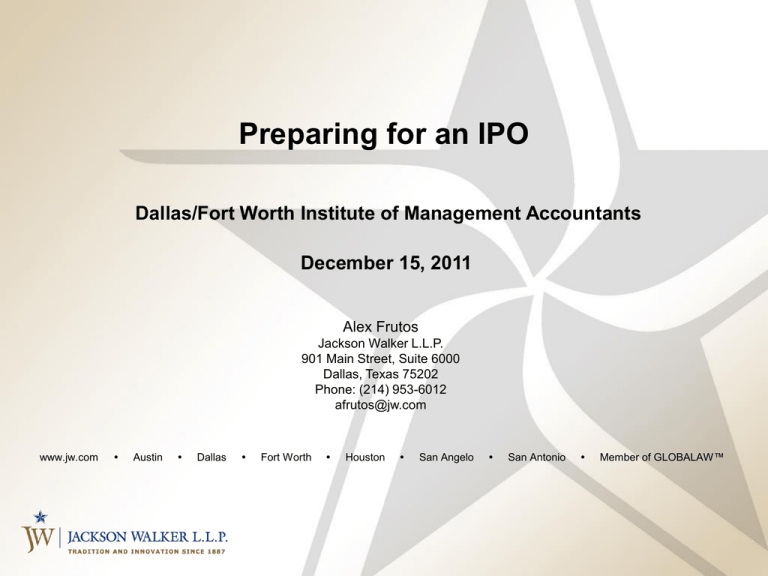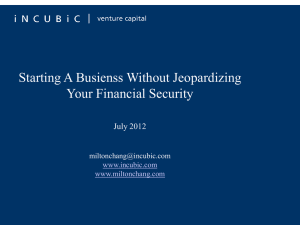PCAOB Auditing Standard No. 5 Key Facts
advertisement

Preparing for an IPO Dallas/Fort Worth Institute of Management Accountants December 15, 2011 Alex Frutos Jackson Walker L.L.P. 901 Main Street, Suite 6000 Dallas, Texas 75202 Phone: (214) 953-6012 afrutos@jw.com www.jw.com Austin Dallas Fort Worth Houston San Angelo San Antonio Member of GLOBALAW™ Overview • • • • • • • • • • What is an IPO? IPO Activity Benefits of an IPO and Being a Public Company Challenges Faced by Public Companies IPO Preparations IPO Process Legal Matters Financial and Accounting Matters Underwriting Matters After the IPO 2 What is an IPO? • An Initial Public Offering of the shares of a company’s stock • The registered offer and sale of shares to the public following rules and regulations outlined in the Securities Act of 1933, as amended, and promulgated by the SEC • A way for companies that need capital for growth to sell ownership stakes to investors who believe in a company’s future prospects 3 IPO Activity – 25 Largest US IPOs Company Name Visa ENEL SpA General Motors Deutsche Telekom AT&T Wireless Group Kraft Foods France Telecom Telstra Corporation Swisscom United Parcel Service Infineon China Unicom Ltd CIT Group Conoco Blackstone Group L.P. Banco Santander Brasil China Mobile Limited Travelers Property Casual HCA Holdings Telecom Eireann Alstom Goldman Sachs Group Agere Systems China Petroleum (Sinopec) Charter Communications Offer Date 03/18/08 11/01/99 11/17/10 11/17/96 04/26/00 06/12/01 10/17/97 11/17/97 10/04/98 11/09/99 03/12/00 06/16/00 07/01/02 10/21/98 06/21/07 10/06/09 10/15/97 03/21/02 03/09/11 07/07/99 06/19/98 05/03/99 03/27/01 10/12/00 11/08/99 Exchange NYSE NYSE NYSE NYSE NYSE NYSE NYSE NYSE NYSE NYSE NYSE NYSE NYSE NYSE NYSE NYSE NYSE NYSE NYSE NYSE NYSE NYSE Industry Financial Utilities Capital Goods & Services Communications Communications Consumer Communications Communications Communications Transportation Technology Communications Financial Energy Financial Financial Communications Financial Health Care Communications Technology Financial Technology Energy Communications Underwriter J.P. Morgan Merrill Lynch Morgan Stanley Goldman, Sachs & Co. Goldman, Sachs & Co. Credit Suisse Merrill Lynch Credit Suisse Warburg Dillon Read Morgan Stanley Goldman, Sachs & Co. Morgan Stanley Goldman, Sachs & Co. Morgan Stanley Morgan Stanley Santander Investment Goldman, Sachs & Co. Citi BofA Merrill Lynch Merrill Lynch Credit Suisse Goldman, Sachs & Co. Morgan Stanley Morgan Stanley Goldman, Sachs & Co. Deal Size (US$MM) $17,864 $16,452 $15,774 $13,034 $10,620 $8,680 $7,289 $5,646 $5,582 $5,470 $5,230 $4,916 $4,600 $4,403 $4,133 $4,025 $3,965 $3,885 $3,786 $3,758 $3,732 $3,657 $3,600 $3,464 $3,230 4 IPO Activity – Number & Volume of US IPOs 5 IPO Activity – Recent IPOs Date Company Symbol Shares Offered Initial Price 11/17/11 Mattress Firm Holding Corp MFRM 5.56M $19.00 11/16/11 Angie's List Inc ANGI 8.79M $13.00 11/16/11 Delphi Automotive PLC DLPH 24.08M $22.00 11/03/11 Groupon Inc GRPN 35.0M $20.00 08/10/11 Carbonite Inc CARB 6.25M $10.00 07/19/11 Zillow Inc Z 3.46M $20.00 06/23/11 KiOR Inc KIOR 10.0M $15.00 06/14/11 Pandora Media Inc P 14.68M $16.00 05/18/11 LinkedIn Corp LNKD 7.84M $45.00 5.0M $10.00 22.5M $16.00 05/10/11 FriendFinder Networks Inc FFN 03/31/11 GNC Holdings Inc GNC 6 IPO Activity – Upcoming IPOs Company Name/Ticker HomeStreet* Underwriter FBR Capital Markets HMST Peak Resorts PEAK Memorial Production Partners LP MEMP Rose Rock Midstream LP RRMS Sanchez Energy Corporation SN Gazit-Globe* GZT Jive Software JIVE Luxfer Holdings LXFR Bonanza Creek Energy BCEI GSE Holding GSE Laredo Petroleum LPI Michael Kors Holdings KORS FusionStorm Global* FSTM Zynga ZNGA Raymond James Janney Montgomery Scott Citi Raymond James Barclays Capital Citi Johnson Rice & Co. Macquarie Capital Citi Deutsche Bank Securities Morgan Stanley Goldman, Sachs & Co. Jefferies & Co. Credit Suisse Morgan Stanley Credit Suisse Oppenheimer & Co. FBR Capital Markets J.P. Morgan Goldman, Sachs & Co. Morgan Stanley J.P. Morgan FBR Capital Markets Needham & Co. Morgan Stanley Goldman, Sachs & Co. Price Range Shares $22 - $24 7.2 mil $16 - $18 5.0 mil $19 - $21 10.0 mil $19 - $21 7.0 mil $24 - $26 10.0 mil $11 - $11 12.0 mil $8 - $10 11.7 mil $13 - $15 10.8 mil $20 - $22 14.3 mil $13 - $15 9.0 mil $18 - $20 17.5 mil $17 - $19 41.7 mil $12 - $14 13.5 mil $9 - $10 100.0 mil Pricing Week 12/05/11 12/05/11 12/05/11 12/05/11 12/12/11 12/12/11 12/12/11 12/12/11 12/12/11 12/12/11 12/12/11 12/12/11 12/12/11 12/12/11 7 Benefits of an IPO and Being a Public Company • Cash proceeds from an IPO improve financial position • Improved access to capital • Create multiple financing opportunities: equity, convertible debt, cheaper bank loans, etc. • Facilitate acquisitions • Increased public profile, exposure and prestige • Bolster and diversify equity base • Increased ability to attract and retain management and employees • Provide stockholders liquidity 8 Challenges Faced by Public Companies • Cost (impact of Sarbanes-Oxley and Dodd-Frank Acts) • Mandatory public disclosure including additional financial disclosure requirements • Restrictions on communications with the investment community and stockholder and security analyst scrutiny • Constraints on trading in the company’s securities • Increased potential liability • Increased corporate governance requirements • Possible loss of control by current stockholders and management • Vulnerability to hostile takeovers • Cultural considerations (effect on management decisions) 9 Increased Public Scrutiny • • Public companies face significantly higher scrutiny than private companies Effective and timely communication to The Street will strengthen a public company’s credibility, which is key to valuation Public Company Private Company • Accountability • Accountability – – – – External stockholders Research Analysts Management Board of Directors • Disclosure – Quarterly SEC filings – Detailed review of operating results – Quarterly investor calls – Forecasting – Thorough – Precise – Conservative – Critical to meet or exceed Street expectations – missing a quarterly earnings target can reduce a company’s stock price significantly – Management – Stockholders – Board of Directors • Disclosure – Summary results to stockholders – Management accounting • Forecasting – Primarily for budgeting – Missing budgeted numbers may impact bonus payments but does not necessarily weaken a company’s competitive position. 10 IPO Preparations and Readiness • • • • • • • • • • Existence of favorable financial history and outlook Corporate organization, size and structure Directors and Management Accounting issues Organizational documents Anti-takeover provisions Company contracts Due diligence preparation Experienced IPO counsel and accounting firm Establish website and public communications policy 11 IPO Process IPO steps include the following: – The company must select an underwriting team to manage the public offering of securities; the underwriters will undertake due diligence and negotiate an underwriting agreement that is reviewed by FINRA – The company must complete an audit of its financial statements for the last two to three years – The company, working with its underwriters, auditors and counsel, must prepare a registration statement and file it with the SEC along with amendments thereto necessitated by comments received from the SEC – The company, working with its underwriters, must market its securities to potential investors (the “road show”) – The company must file a listing application and take other necessary steps for listing its common stock on a national securities exchange, such as the NYSE or the Nasdaq Stock Market – The company must select a transfer agent and registrar for its common stock 12 IPO Process – Composition of Working Group Hire the Team • Company management team • Lead manager • Co-managers • Issuer’s counsel • Underwriters’ counsel • Accountants Organizational Meeting • Structure • Timeline and Allocation Responsibility • Offering Issues • Due diligence • Disclosure 13 IPO Process – Timeline 6-12 months prior to IPO Company rounds out management team (if needed) Focus on “corporate cleanup” 4-6 months prior to IPO Company decides formally to do IPO Appoint underwriter Publicity restrictions commence 2 months prior to first SEC filing Conduct due diligence Complete prospectus drafting Adopt publicco. policies, controls, and procedures, if not already done Initial SEC filing 4 weeks after filing File Form S-1 with SEC and submit application to national securities exchange Receive first SEC comments 2-3 weeks after receipt of SEC comments File revised Form S-1 Comments at 2-4 week intervals Typically 2 to 4 months after first filing Typically 2-3 weeks IPO becomes effective Receive and respond to follow on rounds of SEC comments Resolve material SEC comments Salesforce presentation and Road show Form S-1 declared effective National Securities Exchange approval 3-4 days following pricing Close offering Price deal Shares commence trading Bulk print preliminary (“red”) prospectus Complete audit and review of financials Address corporate governance matters 14 IPO Process – Timeline Pre-Filing Phase SEC Review Phase Marketing Phase Pricing, Trade and Follow-up support • Due Diligence • Draft roadshow presentation • Respond to SEC Comments •Print and distribute “red herrings” •Analyst presentation to underwriters’ sales forces •Target Key Investors •Invitation of Underwriting syndicate •Sell-side analyst presentation by Company •Roadshow presentations •Begin development of institutional and retail “books” of demand •Probe pricing sensitivity • Structuring • Valuation • Choose comanagers • Documentation • Positioning • File Registration Statement • Exchange listing process •Determine appropriate mix of retail and institutional allocations •Determine IPO price •Trading begins •Closing •On-going research 15 IPO Process – Structure of Offering • Size of offering, valuation and use of proceeds – Use of proceeds – Primary and secondary components – Number of shares authorized • • • • Listing on an exchange Status of mezzanine financing Existing stockholder list Lock-up agreements with company, principal stockholders, officers, directors • Distribution objectives/syndication • Directed share program 16 IPO Process – Listing on an Exchange • Stock Exchange Listing – Selection of listing exchange: NYSE or Nasdaq Stock Market – Selection of stock symbol • NYSE and NYSE Amex • NASDAQ Stock Market is comprised of three market tiers: – (1) the NASDAQ Global Select Market – (2) the NASDAQ Global Market, formerly the NASDAQ National Market – (3) the NASDAQ Capital Market, formerly the NASDAQ SmallCap Market • For a company to trade on an exchange, it must meet the exchange’s initial and ongoing listing requirements which consist of the following. – Quantitative requirements—minimum thresholds for the number of publicly traded shares, stock price, number of shareholders, market capitalization, net income, and assets – Qualitative requirements—shareholder approval, board and committee composition and other corporate governance requirements 17 IPO Process – Due Diligence • Business Overview – – – – – – – History Mission statement/vision Objectives and key challenges Operational overview Management team/organizational chart Key investment highlights Strategic position in the industry • Industry Overview/Market Opportunity – – – – – – – Industry size/growth rates Market drivers Major industry trends (spending, commissions, etc.) Consolidation Segmentation/target markets Cyclicality Regulatory environment 18 IPO Process – Due Diligence (cont’d) • Products/Services – Description of each major product/service category – Market size by category – Sales and margins by product/service category • Customers – Breakdown of total customers/subscribers (business vs. consumer, small vs. large, etc.) – Historical growth in customers/subscribers – Concentration past 3 years and projected – Revenue breakdown (by service, customer, industry, geography) – Recent major wins/losses and reasons – Customers at risk – Summary of contract terms for key customers • Suppliers – List of key suppliers (number, sourcing policy, relationships, price volatility) • Growth Strategy and Projections – Organic growth opportunities – Strategy for growing below-the-line business – Key areas for new development 19 IPO Process – Due Diligence (cont’d) • Detailed Financial Review – Reconciliation of budget vs. actual results – Annual historical/pro forma financial data and key operating statistics – 3-year projected financial results Detailed model including income statement, balance sheet, cash flow – Sales and profitability breakdown between traditional and below the line services – Financial objectives (revenue growth, operating margin, leverage statistics, etc.) – Major accounting issues (revenue recognition, receivables, write-off policies, reserves, etc.) – Exposure to exchange rates and how foreign currency exposure is managed – Internal auditing procedures – Tax position, current and future 20 IPO Process – Due Diligence (cont’d) • Budgeting/Forecasting Process • Personnel – Recent and planned management changes – Compensation philosophy (salary vs. bonus, how bonuses are determined, share ownership, etc.) – Employee recruitment and retention strategies – Significant employment agreements • Acquisitions/Ventures – Any planned or pending acquisitions • Legal 21 IPO Process – The Registration Statement • A Registration Statement on Form S-1 is required to be filed with the Securities and Exchange Commission – Disclosure requirements of the form refer to specific sections of Regulation S-K and Regulation S-X • Initial draft prepared by the company and its counsel and revised during drafting sessions with underwriters and underwriters’ counsel throughout the course of the IPO process • The registration statement includes the prospectus which serves the purposes of public disclosure and marketing • Potential liability for material misstatements and omissions in the registration statement under Sections 11, 12(a)(2), 15 and 17(a) of the Securities Act and Sections 8 and 10 of the Exchange Act 22 IPO Process – The Registration Statement Contents of a Registration Statement on Form S-1 • • • • • • • • • • • • • • • Prospectus Summary Risk Factors Use of Proceeds Capitalization, Dividend Policy, Dilution Selected Financial Data Management’s Discussion and Analysis (MD&A) Business – – – – – Overview Industry Competitive strengths/solution Strategy Products – – – – – R&D Manufacturing Sales & Marketing Competition Customers – – – – Environment Properties Employees Litigation Management and Executive Compensation Principal and Selling Stockholders Related Party Transactions Description of Capital Stock Shares Eligible for Future Sale Underwriting Financial Statements Exhibits 23 IPO Process – The Registration Statement • SEC’s Division of Corporation Finance will take approximately 30 days to review the registration statement – technical issues—compliance with the specific rules of the SEC – disclosure issues—adequacy of the risk factors, issues regarding information found in company press releases, web site or thirdparty statements but not reflected in the registration statement – drafting issues—compliance with the SEC’s Plain English rules – accounting issues • Typically, issuer will file a response letter including an amendment to the registration statement within 1-2 weeks of receipt of an SEC comment letter 24 IPO Process – Publicity • There are specific restrictions on publicity during the quite period and the waiting period • Quiet period begins with the organizational meeting – – – – offers of securities prohibited Issuers are prohibited from conditioning the market, known as gun jumping SEC could force a cooling off period Safe harbors exist for regularly released, ordinary course communications Rule 163A and Rule 169 No reference to securities offering • Waiting period begins upon filing of the registration statement – Offers to sell securities allowed in a free writing prospectus as long as preceded by a statutory prospectus • Carefully review all communications – – – – Issuer web site Industry presentations Press releases/other corporate announcements Interviews or articles on company to be published 25 Legal Considerations • Board of Directors at IPO – independence — a majority of Board must be independent – committees of all independent directors: audit, compensation and nominating and corporate governance committees – audit committee "financial expert" required a CPA and/or former CFO or audit firm partner – director compensation for Board and committees cash compensation: cash retainer vs. per meeting fees equity compensation: options, restricted stock chairman fees; for Board and committees • Officers – – – – – • titles — review and reconsider management structure and titles "executive" officers vs. "Senior" officers Section 16 insiders - reporting and compliance issues (a/k/a Form 4 filers) employment agreements incentive arrangements and plans Directors and officers liability insurance at IPO – coverage amount and deductibles – increased cost of coverage at IPO 26 Legal Considerations • • • Employees – non-compete, non-solicitation and confidentiality arrangements – incentive arrangements and plans Equity plans – compliance with tax and securities laws — 162(m), 409A and Rule 701 – consider new plans or plan amendments – SEC registration of restricted stock and option shares (Form S-8) Charter, Bylaws and Corporate Records – Review charter and bylaws and amend where necessary review capital structure (make sure that there will be sufficient common stock and blank check preferred) antitakeover provisions, such as a staggered board review indemnification provisions – – – – review corporate structure consider creating holding company structure consider need for existing subsidiaries tax issues 27 Legal Considerations • Share capital – review and clean up existing shareholder list registration rights/notice and/or waiver lock-ups by directors, officers and shareholders – are there lock-ups under existing agreements – new lock-ups to underwriter - 180 days after pricing – lock-ups in option agreements preemptive rights; antidilution provisions accuracy and completeness of stock book – identify all issuances of shares since formation – shares authorized and outstanding - amend charter as necessary – transition stock recordkeeping to transfer agent – stock options and/or restricted stock outstanding and to be granted 28 Legal Considerations • Underwriting Agreement with the Underwriters – Best efforts vs firm commitment underwriting – Overallotment option (green shoe) • • Exchange Listing Corporate Governance – – – – • Pre IPO Annual Meeting of Shareholders – – – – • • new Board Committee charters - public company versions Code of Conduct that includes Code of Ethics Insider Trading Policy Disclosure Controls and Procedures for SEC filings adopt restated charter adopt/amend equity plans other required actions avoids Annual Meeting immediately after IPO Outstanding litigation and/or claims — resolve if practical to do so Third-party consents required (loan; stockholder and other agreements) 29 Legal Considerations • Disclosure issues – confidentiality agreement restrictions – material contracts identify material contracts disclosure issues file as exhibits to registration statement confidential treatment requests – related party transactions and agreements – – – – – – – identify related party relationships consider if advantageous to continue review documentation ratification by independent directors employment agreements executive compensation arrangements option and/or restricted stock grants to executive officers pending acquisitions, divestitures, restructuring or other material transactions regulatory matters antitakeover provisions D&O questionnaires - identify any issues raised by responses 30 Financial and Accounting Matters • • • • • • • • • • • • • Historical audited financial statements (3 years) Identify any unusual items requiring advance discussion with SEC Historical option pricing or other potential cheap stock issues Historical revenue recognition policy Segment Reporting SEC requirements for separate audited financials in connection with acquisitions Pro forma presentations Goodwill/intangibles Management's Discussion and Analysis of Financial Condition and Results of Operations Comfort letter from auditors to underwriters Management letters Availability and discussion of forecast information Tax issues — NOLs (Section 382 analysis) 31 Financial and Accounting Matters Key activities for financial reporting include: • Internal controls over financial reporting • Assessing the availability and quality of financial data in light of GAAP and identifying what new data will be required and the sources for that data and the costs of developing it • Developing processes to draft financial reports and the registration statement according to GAAP, and developing the resources to support those processes • Considering the competencies and competing commitments of staff and how best to address any shortcomings or needs • Integrating financial reporting with compliance, governance, and risk management to generate information that not only meets reporting requirements but also guides management decisions and drives performance improvements 32 Underwriters – Role of Equity Research • Accountable to the investor • Perform detailed due diligence on company and its prospects • Develop financial model – – – – Articulate “the story” to investors during IPO marketing Source of independent valuation Provide institutions with analytical framework Maintain close communication with institutions throughout marketing process and beyond • Initiate written research coverage on company following 25-day “coolingoff” period • Provide ongoing support with frequent reports, conference calls, 1on-1 calls and electronic broadcasts to investment community 33 Underwriters – Approach to Valuation Start wit THE COMPARABLES… Apply the VALUATION BENCHMARKS… Adjust for COMPANY CHARACTERISTICS… and Factor in THE INTANGIBLES • Same industry • Discounted cash flow • Price/Earnings • Enterprise value/EBITDA • PE/Growth rate • Price/Book value • Private market value • Agg. Value/ Revenue •Growth rate (organic and strategic) •Profit margins, existing and opportunities for improvement •Leverage •Off-balance sheet assets •Unquantifiable liabilities •Individual business unit momentum •Geographic mix •Management trackrecord • Competitors • Comparable size of enterprise • Comparable business model • Comparable market opportunity •Existing stockholder sponsorship •Brand appeal •Sector price momentum •Market conditions 34 Underwriters – Roadshow Presentation • Opportunity for company to articulate story and investment opportunity face-to-face investors – roadshow 2 weeks Approximately 100+ face-to-face meetings • Investors are prepared through reading prospectus, discussions with research analysts and salespeople prior to meeting management • Critical juncture in deal process – Investors ask everything required for an informed investment decision 35 Underwriters – Presentation Format • There are three different types of meetings with investors on the roadshow – Group presentations allow the Company to deliver its equity story beyond the “elephant” accounts range from lunches with several hundred investors (e.g., New York) to smaller presentations (e.g., Houston) – One-on-One Presentations expected to generate the majority of quality institutional demand range from meetings with a single portfolio manager / buyside analyst to small group sessions with multiple portfolio managers and buyside analysts – Conference Calls are conducted on an as-needed basis with investors who are unable to work within the schedule will include group as well as one-on-one sessions 36 Underwriters – Pricing Overview • • Once the intended pricing date has been determined, investors are informed of the day and time on which the book will be closed (i.e., the deadline for submitting indications of interest) Once the book has been closed, the lead manager, in consultation with the co-managers, reviews the book of demand in order to assess: – – – – • • • Strength of demand Price sensitivity Investors’ allocation expectations Likelihood of aftermarket buying/selling At the time of pricing, the lead manager reviews the book with the Issuer and recommends an offering price which, in their judgement, will maximize the offering proceeds to the Issuer consistent with a favorable aftermarket performance. Once the Issuer and the managers have agreed on an offering price, the underwriting agreement and the intersyndicate agreements are signed and accountant’s comfort letter is issued Offering closes 3-4 days after pricing 37 After the IPO • Regulation FD • File regularly with the SEC – Earnings announcements—hit your earnings Regulation G – Quarterly and annual financial statements (Quarterly Reports on Form 10-Q and Annual Reports on Form 10-K) – Material corporate events (Current Reports on Form 8-K) – Proxy Statements and/or Information Statements • Section 13(d) and 13(g) Reporting – Schedule 13D/13G • Section 16 Reporting – Forms 3, 4 and 5 38








